window TOYOTA HILUX 2013 (in English) Service Manual
[x] Cancel search | Manufacturer: TOYOTA, Model Year: 2013, Model line: HILUX, Model: TOYOTA HILUX 2013Pages: 644, PDF Size: 34.35 MB
Page 366 of 644
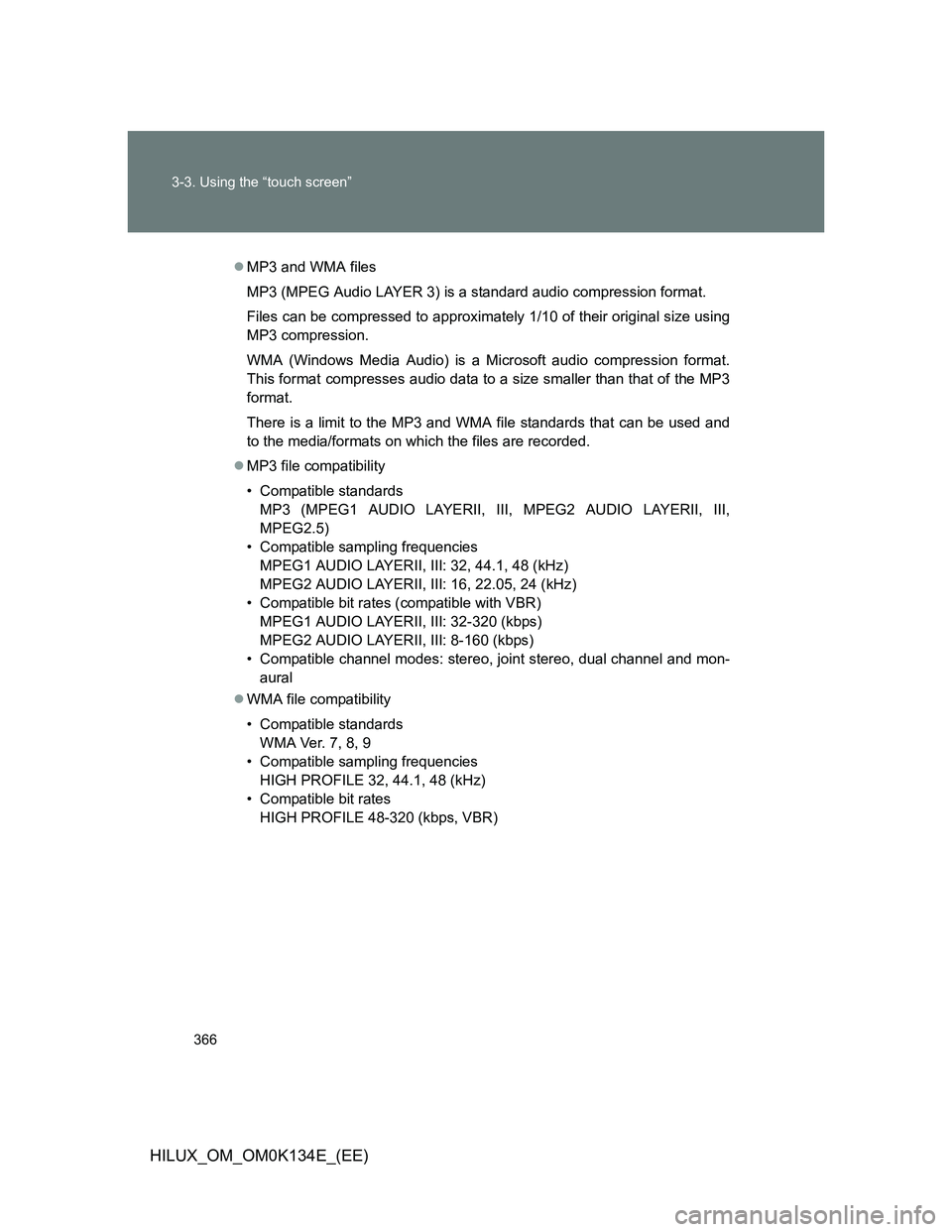
366 3-3. Using the “touch screen”
HILUX_OM_OM0K134E_(EE)
MP3 and WMA files
MP3 (MPEG Audio LAYER 3) is a standard audio compression format.
Files can be compressed to approximately 1/10 of their original size using
MP3 compression.
WMA (Windows Media Audio) is a Microsoft audio compression format.
This format compresses audio data to a size smaller than that of the MP3
format.
There is a limit to the MP3 and WMA file standards that can be used and
to the media/formats on which the files are recorded.
MP3 file compatibility
• Compatible standards
MP3 (MPEG1 AUDIO LAYERII, III, MPEG2 AUDIO LAYERII, III,
MPEG2.5)
• Compatible sampling frequencies
MPEG1 AUDIO LAYERII, III: 32, 44.1, 48 (kHz)
MPEG2 AUDIO LAYERII, III: 16, 22.05, 24 (kHz)
• Compatible bit rates (compatible with VBR)
MPEG1 AUDIO LAYERII, III: 32-320 (kbps)
MPEG2 AUDIO LAYERII, III: 8-160 (kbps)
• Compatible channel modes: stereo, joint stereo, dual channel and mon-
aural
WMA file compatibility
• Compatible standards
WMA Ver. 7, 8, 9
• Compatible sampling frequencies
HIGH PROFILE 32, 44.1, 48 (kHz)
• Compatible bit rates
HIGH PROFILE 48-320 (kbps, VBR)
Page 368 of 644
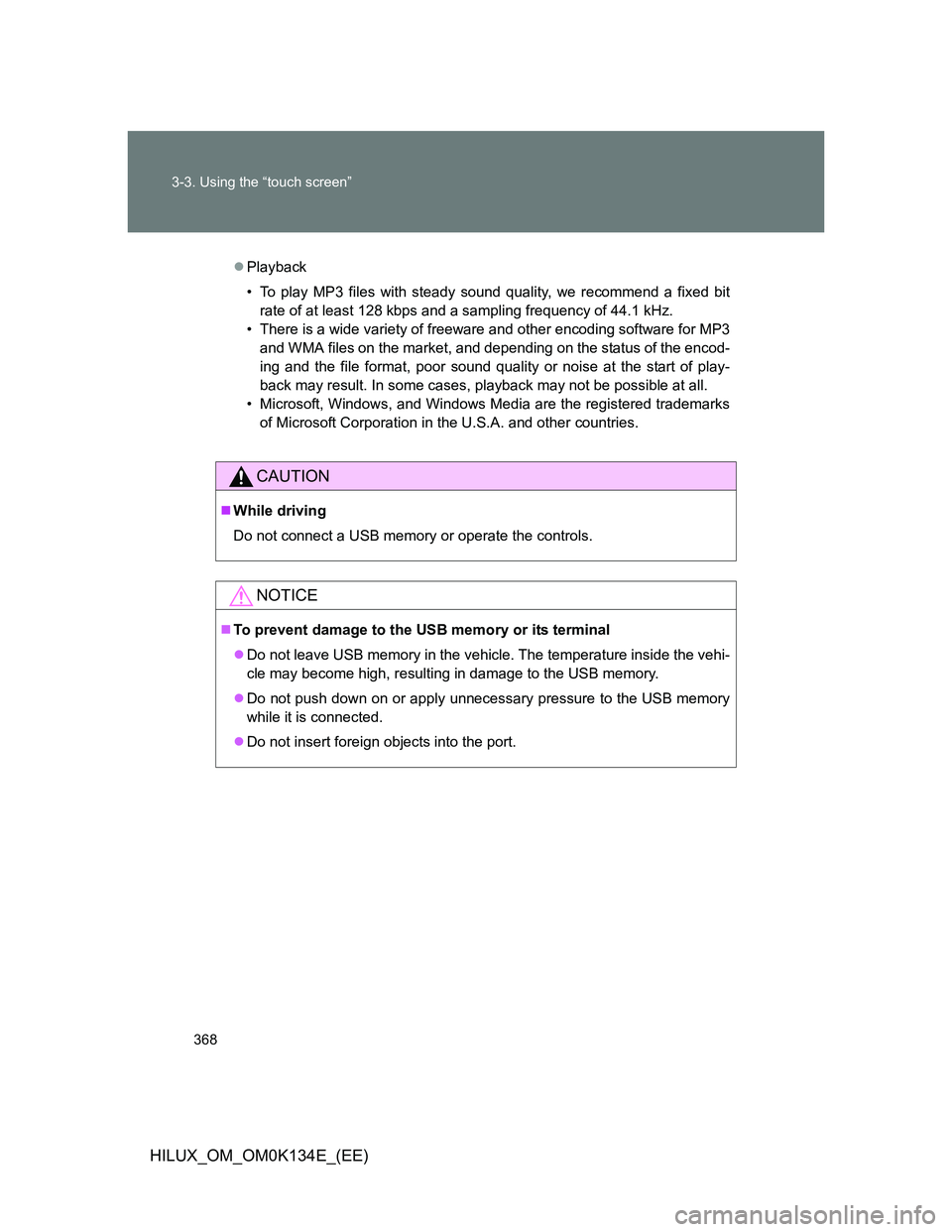
368 3-3. Using the “touch screen”
HILUX_OM_OM0K134E_(EE)
Playback
• To play MP3 files with steady sound quality, we recommend a fixed bit
rate of at least 128 kbps and a sampling frequency of 44.1 kHz.
• There is a wide variety of freeware and other encoding software for MP3
and WMA files on the market, and depending on the status of the encod-
ing and the file format, poor sound quality or noise at the start of play-
back may result. In some cases, playback may not be possible at all.
• Microsoft, Windows, and Windows Media are the registered trademarks
of Microsoft Corporation in the U.S.A. and other countries.
CAUTION
While driving
Do not connect a USB memory or operate the controls.
NOTICE
To prevent damage to the USB memory or its terminal
Do not leave USB memory in the vehicle. The temperature inside the vehi-
cle may become high, resulting in damage to the USB memory.
Do not push down on or apply unnecessary pressure to the USB memory
while it is connected.
Do not insert foreign objects into the port.
Page 390 of 644
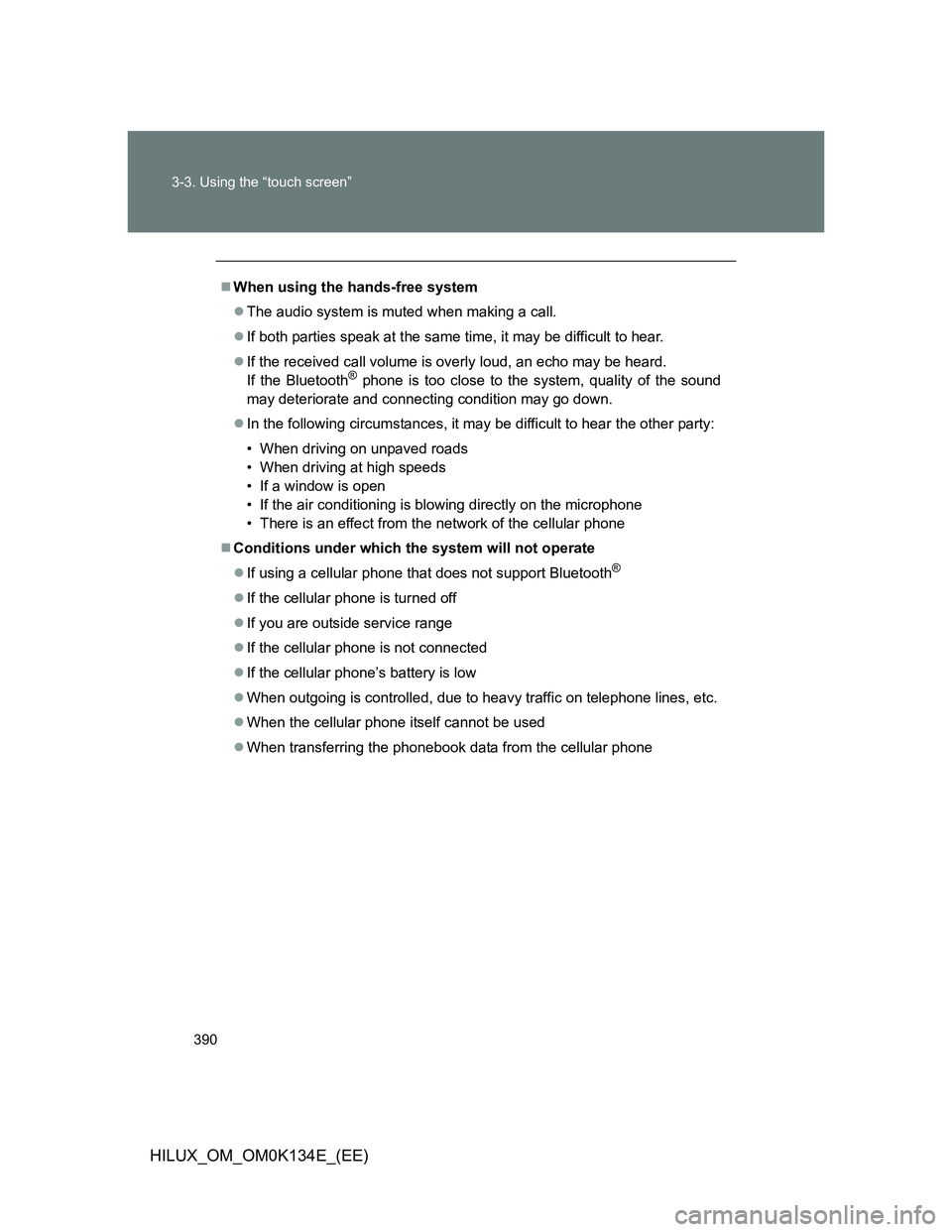
390 3-3. Using the “touch screen”
HILUX_OM_OM0K134E_(EE)
When using the hands-free system
The audio system is muted when making a call.
If both parties speak at the same time, it may be difficult to hear.
If the received call volume is overly loud, an echo may be heard.
If the Bluetooth
® phone is too close to the system, quality of the sound
may deteriorate and connecting condition may go down.
In the following circumstances, it may be difficult to hear the other party:
• When driving on unpaved roads
• When driving at high speeds
• If a window is open
• If the air conditioning is blowing directly on the microphone
• There is an effect from the network of the cellular phone
Conditions under which the system will not operate
If using a cellular phone that does not support Bluetooth
®
If the cellular phone is turned off
If you are outside service range
If the cellular phone is not connected
If the cellular phone’s battery is low
When outgoing is controlled, due to heavy traffic on telephone lines, etc.
When the cellular phone itself cannot be used
When transferring the phonebook data from the cellular phone
Page 464 of 644
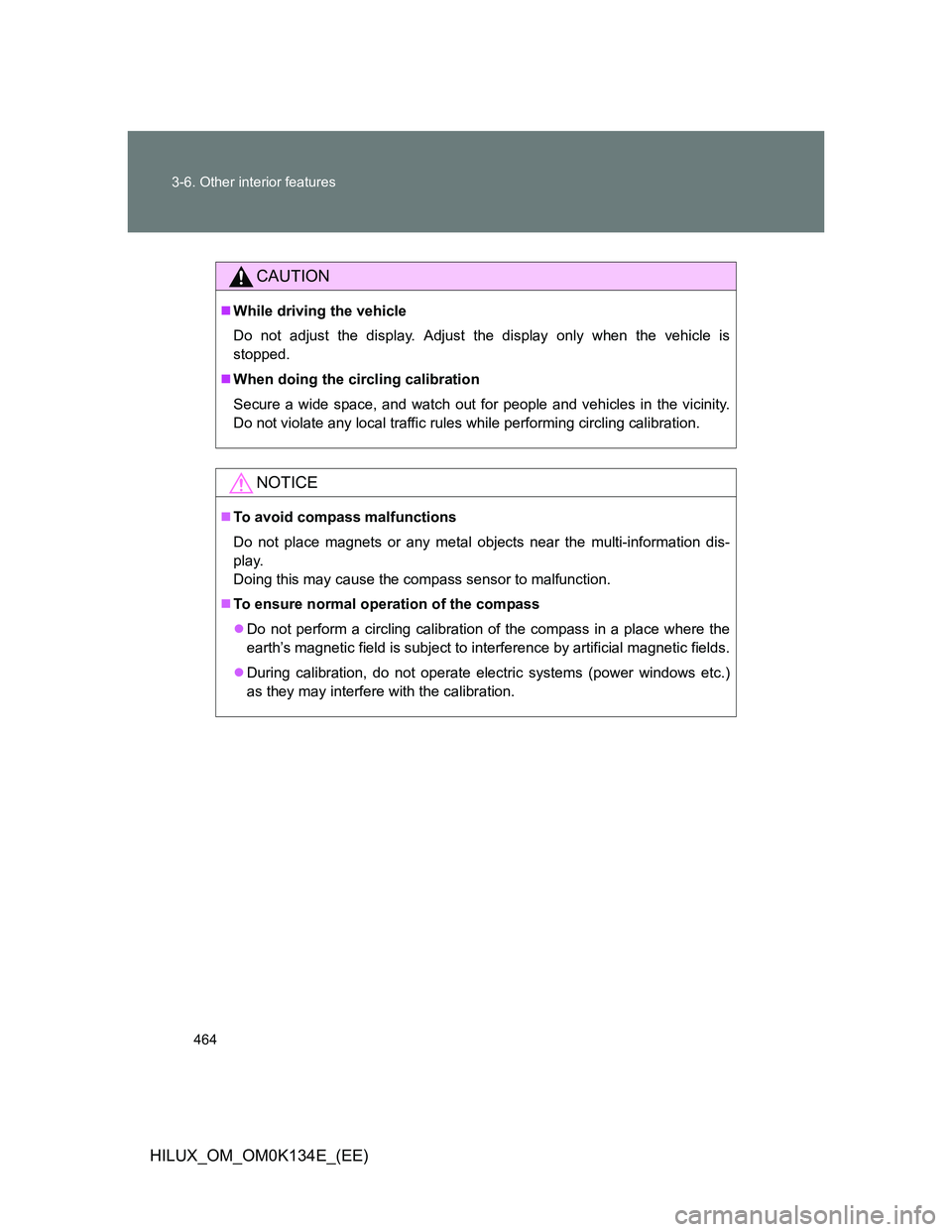
464 3-6. Other interior features
HILUX_OM_OM0K134E_(EE)
CAUTION
While driving the vehicle
Do not adjust the display. Adjust the display only when the vehicle is
stopped.
When doing the circling calibration
Secure a wide space, and watch out for people and vehicles in the vicinity.
Do not violate any local traffic rules while performing circling calibration.
NOTICE
To avoid compass malfunctions
Do not place magnets or any metal objects near the multi-information dis-
play.
Doing this may cause the compass sensor to malfunction.
To ensure normal operation of the compass
Do not perform a circling calibration of the compass in a place where the
earth’s magnetic field is subject to interference by artificial magnetic fields.
During calibration, do not operate electric systems (power windows etc.)
as they may interfere with the calibration.
Page 469 of 644

469 4-1. Maintenance and care
4
Maintenance and care
HILUX_OM_OM0K134E_(EE)
High pressure car washes
Do not allow the nozzles of the car wash to come within close proximity
of the windows.
Before using the car wash, check that the fuel filler door on your vehicle
is closed properly.
Aluminum wheels (if equipped)
Remove any dirt immediately by using a neutral detergent. Do not use
hard brushes or abrasive cleaners. Do not use strong or harsh chemical
cleaners.
Use the same mild detergent and wax as used on the paint.
Do not use detergent on the wheels when they are hot, for example after
driving for long distance in the hot weather.
Wash detergent from the wheels immediately after use.
Bumpers
Do not scrub with abrasive cleaners.
CAUTION
When washing the vehicle
Do not apply water to the inside of the engine compartment. Doing so may
cause the electrical components etc. to catch fire.
Precautions regarding the exhaust pipe
Exhaust gasses cause the exhaust pipe to become quite hot.
When washing the vehicle, be careful not to touch the pipe until it has cooled
sufficiently, as touching a hot exhaust pipe can cause burns.
Page 475 of 644
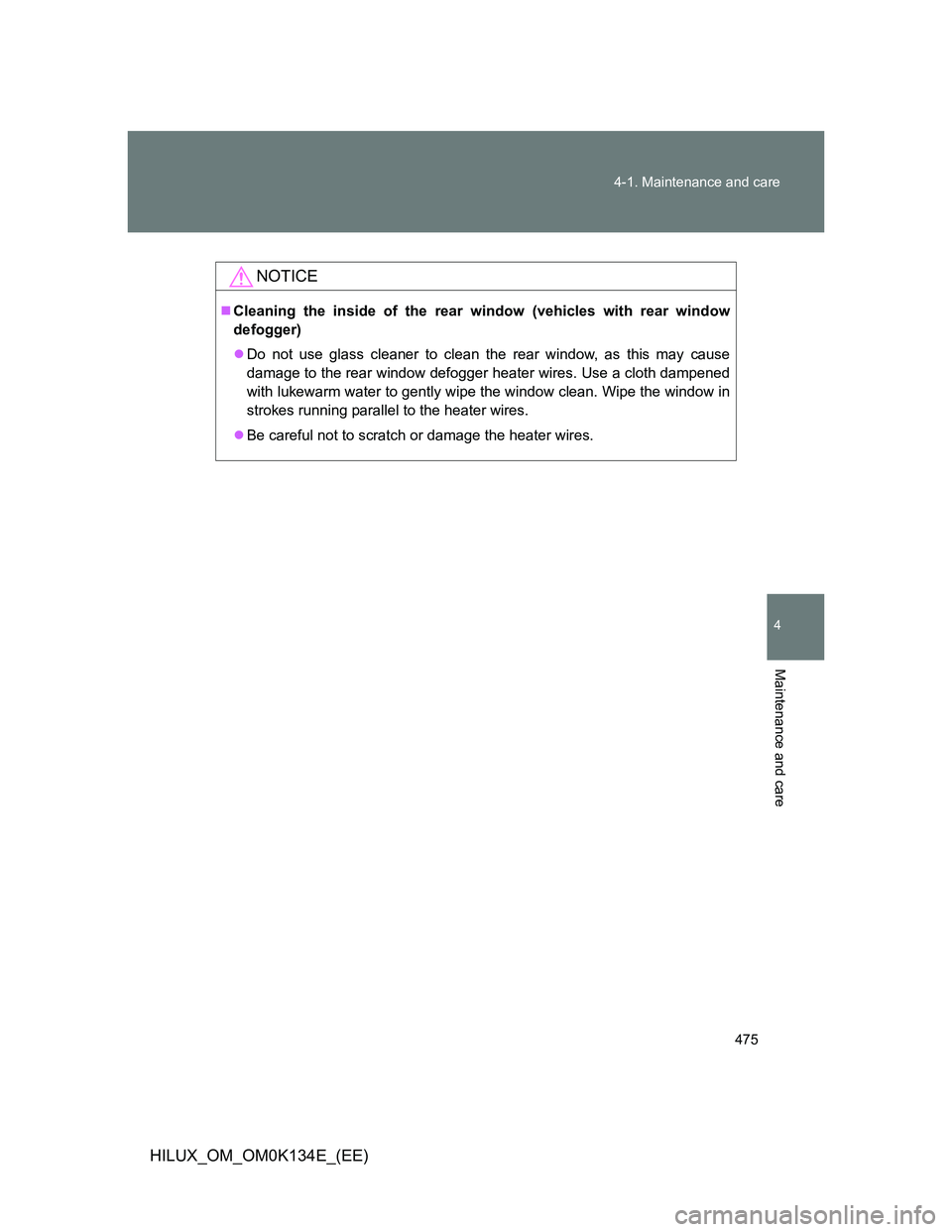
475 4-1. Maintenance and care
4
Maintenance and care
HILUX_OM_OM0K134E_(EE)
NOTICE
Cleaning the inside of the rear window (vehicles with rear window
defogger)
Do not use glass cleaner to clean the rear window, as this may cause
damage to the rear window defogger heater wires. Use a cloth dampened
with lukewarm water to gently wipe the window clean. Wipe the window in
strokes running parallel to the heater wires.
Be careful not to scratch or damage the heater wires.
Page 478 of 644
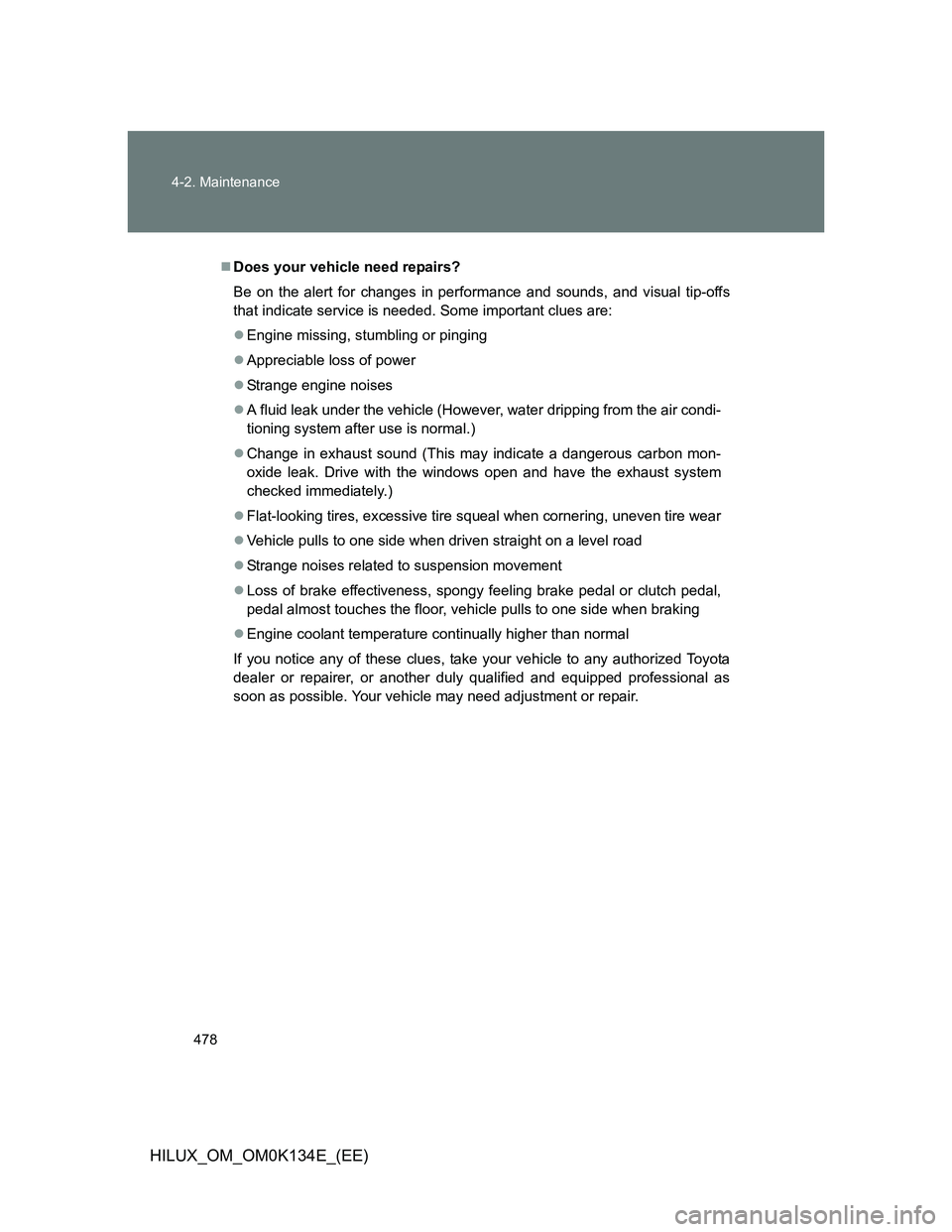
478 4-2. Maintenance
HILUX_OM_OM0K134E_(EE)
Does your vehicle need repairs?
Be on the alert for changes in performance and sounds, and visual tip-offs
that indicate service is needed. Some important clues are:
Engine missing, stumbling or pinging
Appreciable loss of power
Strange engine noises
A fluid leak under the vehicle (However, water dripping from the air condi-
tioning system after use is normal.)
Change in exhaust sound (This may indicate a dangerous carbon mon-
oxide leak. Drive with the windows open and have the exhaust system
checked immediately.)
Flat-looking tires, excessive tire squeal when cornering, uneven tire wear
Vehicle pulls to one side when driven straight on a level road
Strange noises related to suspension movement
Loss of brake effectiveness, spongy feeling brake pedal or clutch pedal,
pedal almost touches the floor, vehicle pulls to one side when braking
Engine coolant temperature continually higher than normal
If you notice any of these clues, take your vehicle to any authorized Toyota
dealer or repairer, or another duly qualified and equipped professional as
soon as possible. Your vehicle may need adjustment or repair.
Page 527 of 644

527 4-3. Do-it-yourself maintenance
4
Maintenance and care
HILUX_OM_OM0K134E_(EE)
FuseAmpereCircuit
4OBD7.5 AOn-board diagnosis system
5INJ15 A
Multiport fuel injection system/
sequential multiport fuel injection
system
6ECU-IG &
GAUGE10 A
Air conditioning system, charging
system, rear differential lock sys-
tem, ABS, TRC, VSC, emergency
flashers, turn signal lights, back-up
lights, multiport fuel injection sys-
tem/sequential multiport fuel injec-
tion system, shift lock control
system, rear window defogger,
headlights, door courtesy switches,
power door lock system, wireless
remote control system, steering
sensor, daytime running light sys-
tem, cruise control, headlight clean-
ers, seat heaters, outside rear view
mirror defoggers, multi-information
display and passenger’s seat belt
reminder light
7WIP20 AWindshield wiper and washer
8IGN7.5 A
Multiport fuel injection system/
sequential multiport fuel injection
system, SRS airbags and fuel pump
9ACC7.5 A
Audio system, power outlet, clock,
power rear view mirror control sys-
tem, shift lock control system and
multi-information display
Page 530 of 644
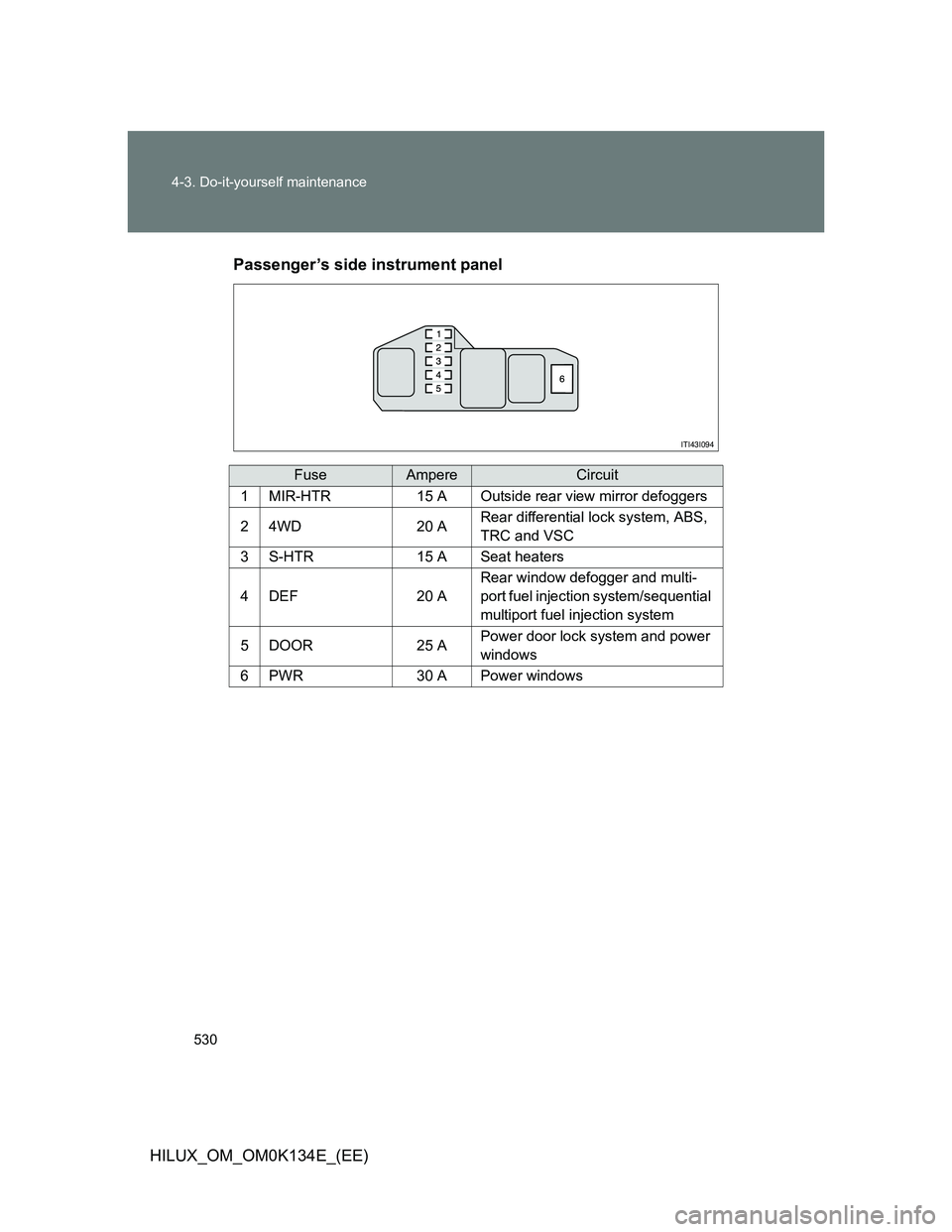
530 4-3. Do-it-yourself maintenance
HILUX_OM_OM0K134E_(EE)Passenger’s side instrument panel
FuseAmpereCircuit
1MIR-HTR15 AOutside rear view mirror defoggers
24WD20 ARear differential lock system, ABS,
TRC and VSC
3S-HTR15 ASeat heaters
4DEF20 A
Rear window defogger and multi-
port fuel injection system/sequential
multiport fuel injection system
5DOOR25 APower door lock system and power
windows
6PWR30 APower windows
ITI43I094
Page 589 of 644

5
589 5-2. Steps to take in an emergency
When trouble arises
HILUX_OM_OM0K134E_(EE)
Starting the engine when the battery is discharged (vehicles with auto-
matic transmission)
The engine cannot be started by push-starting.
To prevent battery discharge
Turn off the headlights and the audio system while the engine is off.
Turn off any unnecessary electrical components when the vehicle is run-
ning at a low speed for an extended period, such as in heavy traffic.
When the battery is removed or discharged
The power windows must be initialized. (P. 92)
Charging the battery
The electricity stored in the battery will discharge gradually even when the
vehicle is not in use, due to natural discharge and the draining effects of cer-
tain electrical appliances. If the vehicle is left for a long time, the battery may
discharge, and the engine may be unable to start. (The battery recharges
automatically during driving.)
Start the engine of the second vehicle. Increase the engine
speed slightly and maintain at that level for approximately 5
minutes to recharge the battery of your vehicle.
Maintain the engine speed of the second vehicle and start
the engine of your vehicle.
Once the vehicle’s engine has started, remove the jumper
cables in the exact reverse order from which they were con-
nected.
Once the engine starts, have the vehicle inspected at any autho-
rized Toyota dealer or repairer, or another duly qualified and
equipped professional, as soon as possible.STEP2
STEP3
STEP4